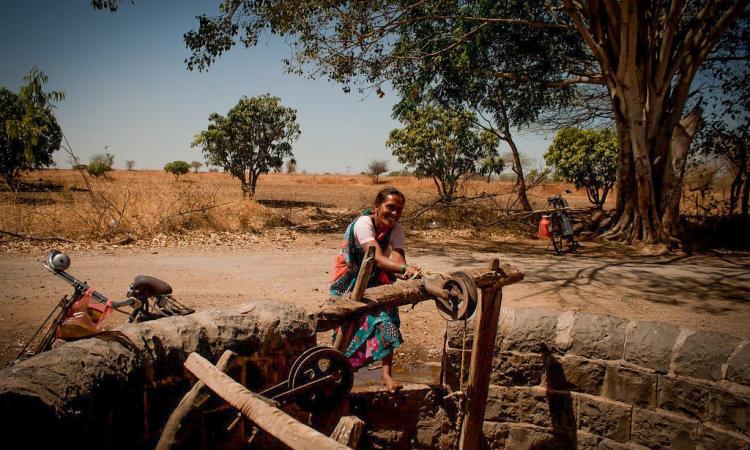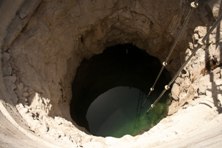
On October 11, 2014, the Government of India launched an ambitious scheme for village development – the Saansad Aadarsh Gram Yojana (SAGY). The scheme requires ‘saansads’ or elected MPs to convert 3 villages in their constituency into ‘Adarsh Grams’ or model villages worthy of replication elsewhere in the country.
It endorses an integrated approach towards development that includes better and improved physical infrastructure in the villages, along with building community spirit. It aims for better governance (transparency, accountability and integrity), active people’s participation (mutual cooperation, self-help & self-reliance and improved standard of living & quality of life), and environmental consciousness that can be replicated. It hopes to use the resources from existing schemes for furthering the cause of these villages.
In the water sector, the scheme takes a leaf out of the Hiware village attempt to develop integrated water conservation measures so as to make the village water-secure and free of drought.
How will this scheme work? What are its expected outcomes? Let's take a look at what SAGY implies.
How to choose an ‘Adarsh Gram’
The Gram Panchayat is the basic unit; MP’s will identify a Gram Panchayat other than his/her own or their spouse’s village; Lok Sabha MP will choose from within his/her constituency; Rajya Sabha MP will choose from the rural area of a district in the State from where elected; Nominated MPs will choose from rural areas of any district; For urban constituencies, MP will identify a Gram Panchayat from a nearby rural constituency.
Steps to become an ‘Adarsh Gram’
Though each village will have its own individual topical solution, the following points are essential:
- Identify people’s needs and priorities
- Define activities that can mobilize the complete community
- Use resources from running government schemes
- Repair and renovate existing infrastructure
- Strengthen the Gram Panchayat
- Promote transparency and accountability
Interesting features of the scheme
- Nearly 2370 ‘Adarsh Grams’ will be created by 2019: One Adarsh Gram to be selected and developed by 2016 and then two more by March 2019, followed by selecting and developing five Adarsh Grams (one per year) by 2024.
- Resource mapping: Even as a Village Development Plan is to be prepared for every identified Gram Panchayat, an important component is the local resource map. It is to be created by the locals and will mark the natural and physical resources existing and available at the village level itself. This should help the community to realise its assets and then work forward from there. From the water perspective also, this will be essential as it will clearly show the current status of water bodies, slope of the land, and help delineate the micro-watersheds. The data collected will be captured on a GIS platform and will serve as an added bonus.
- Funds from existing schemes: Even as the MPs are the pivot for the SAGY, no new funds have been allocated for this. It will converge as much as possible resources from the central sector, centrally sponsored schemes and also other State schemes. Some of the existing schemes expected to facilitate this aim are MGNREGA, Swachh Bharat Abhiyaan, MPLADS, IWMP, National Rural Drinking Water Programme, MNRE, Schemes of Ministry of Agriculture.
SAGY on the ‘Water & Sanitation’ front
The aim of SAGY is to develop a village along the principles of watershed management through:
- the scientific and participatory assessment of the health of the watershed to provide drinking water, preferably treated piped water with household taps;
- to conduct surveys to identify existing and potential sources of drinking water in order to prepare a village water security plan;
- to encourage rainwater harvesting as a traditional practice by integrating rooftop rainwater harvesting into toilet units and reviving traditional structures;
- to ensure ‘Clean Villages' by better access to sanitation through household toilets, toilets in public institutions, IEC initiative and solid and liquid waste management.
Several villages in India have already accomplished these aims using water as the entry point. How did they achieve water security while simultaneously building the skills of the youth and helping improve governance? Can these villages serve as a model for the Yojana?
Putting SAGY aims into practice: Achieving water security through the Participatory Groundwater Management (PGWM) programme
One such way to end the water woes of a village is the Participatory Groundwater Management programme. The SAGY guidelines provide a unique opportunity for dovetailing principles of sustainable groundwater management while helping build skills of the youth and strengthening governance at the village level. On the other hand PGWM is a way to demonstrate sustainable use and management of groundwater through the participation of communities.
A paradigm such as PGWM helps to bridge certain gaps within groundwater-related programmes and allied projects such as watershed management and drinking water and sanitation. The main gaps faced in such programmes are:
- Knowledge regarding the resource base; existing information is largely inaccessible;
- Capacity to look beyond the conventional - demystifying subjects like geology and hydrogeology - does not figure within any current mainstream agenda, least of all in our academic curricula;
- Field-based work, especially good hydrogeological mapping;
- The linkages between the problems and overall understanding of the resource.
Where has PGWM been applied?
The principles of participatory groundwater management have been applied in all districts in Sikkim; Randullabad, Muthalne villages in Mahrashtra; villages in the Kankavati sandstone area and the Kamaguna-Vatachchad areas of Gujarat; 4 villages in Pargi cluster in Telangana & Thanakasoga Panchayat in Himachal Pradesh.
How has PGWM helped achieve water security for the village?
Capacity building: Training modules were designed and implemented for various levels of target groups, ranging from village water committee members to policy makers, viz-a-viz:
- Policy level with specific target groups such as Planning Commission, Central and State Departments;
- To orient and sensitize IWMP programme staff (Watershed Development Team) to incorporate PGWM planning in DPRs;
- Village- level and regional workshops (block and district) to educate and empower community for decision making.
More than 100 training sessions were conducted in 3 years and more than 5000 people were trained in a variety of topics starting from data collection for hydrogeology to crop water budgeting. This has also helped develop barefoot para-workers who can create water security plans and can now go beyond their village and help other areas too.
For example, the para-workers of the Arid Communities and Technologies (ACT), a group working with communities in the arid district of Kutch, Gujarat, have formed their own company to provide services to both villages and industries that want to better manage their water.
Use of science for technically sound water security plans: The first step in scientific management is to understand the basic unit of planning. In the case of groundwater, it is an aquifer. Thus, the aquifer boundaries need to be delineated and its nature understood. The cadre of people trained in hydrogeology were able to do this by collecting a variety of data such as rainfall, depth of water in the well/ discharge rate of the spring (depending on the source), water quality, evaporation, rate of evapotranspiration, etc. Physical exercises were also carried out to understand the rock type and local hydrogeology features.
Based on this data, 7 basic maps were created to help identify the aquifer and it’s features. This map and the data helped draw out the amount of water available and how much was used. Based on all this information, water security plans were drawn up for the village. In addition to this, protocols for water management were evolved by the community based on an understanding of whether they were water- surplus or water- deficient.
Identifying resource envelopes: Once the water security plans were drawn up, it became important to find the resource envelope within which to implement them. To strengthen governance, all four institutions worked with the Gram Panchayats who got the plans passed in their Gram Sabhas. This helped leverage government schemes for implementation. On the other hand, the work also found traction with state level implementers of schemes such as the Integrated Watershed Management Plan (IWMP) and Indira Jala Prabha (Andhra Pradesh). Several state cadre people in the Watershed Development Team were trained to incorporate principles from PGWM. Two organisations also worked with NABARD to help the NGOs who were their project facilitation agencies to implement PGWM at a watershed level.
 An 'Adarsh Gram', post PGWM- implementation
An 'Adarsh Gram', post PGWM- implementation
The PGWM initiative helped create decision support for the community, which helped them promote groundwater management. In some of the villages, the communities accepted groundwater as a common pool resource and came up with criteria to manage the demand together. This was based on an understanding of water availability every year, which was made possible by the data they had collected. They also created protocols for water use that were approved in the Gram Sabhas. In Maharashtra, and Telengana the findings were further used to help farmers decide the most profitable crops that should be grown based on water availability.
Awareness and community-level action are key to the success of any initiative; six villages in Maharashtra are testimony to that and also to the fact the PGWM programme can indeed make a gram an 'Adarsh Gram'.